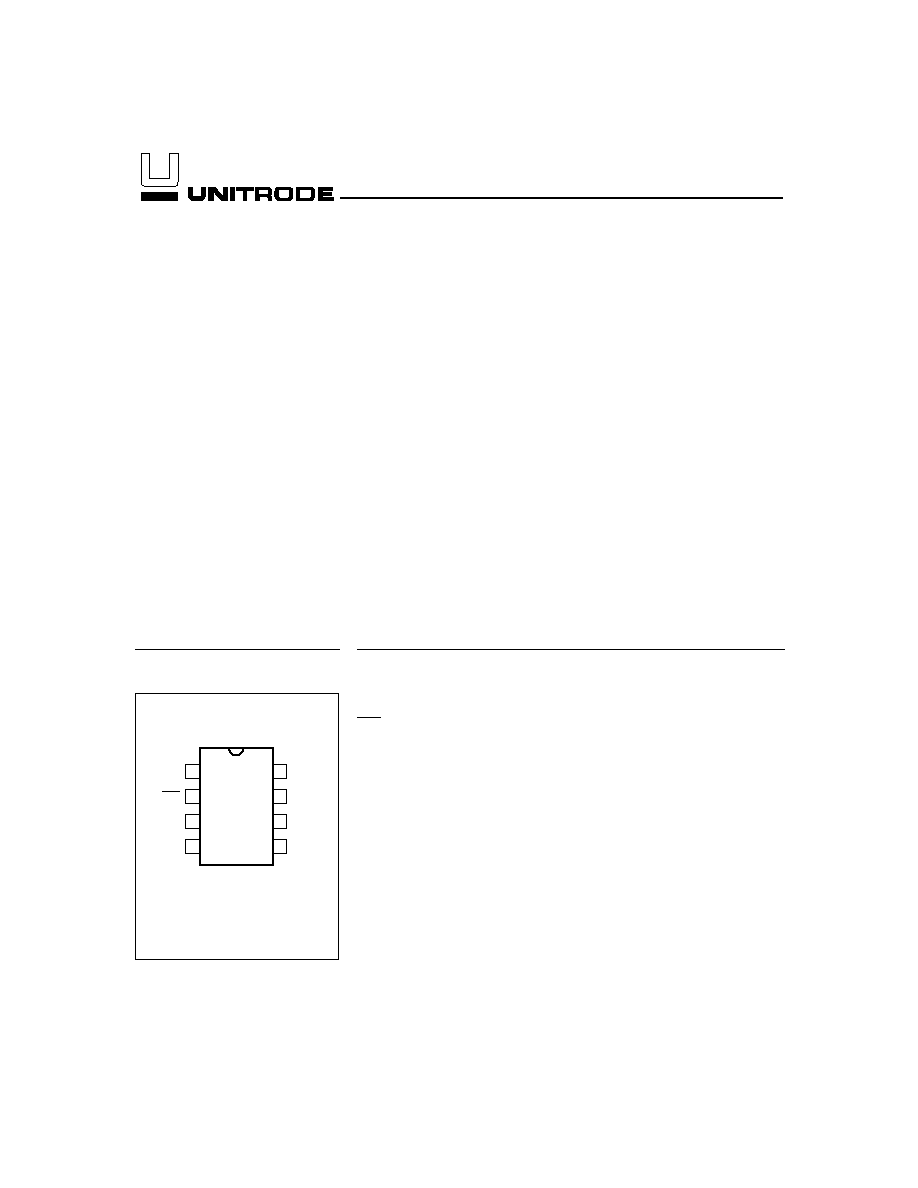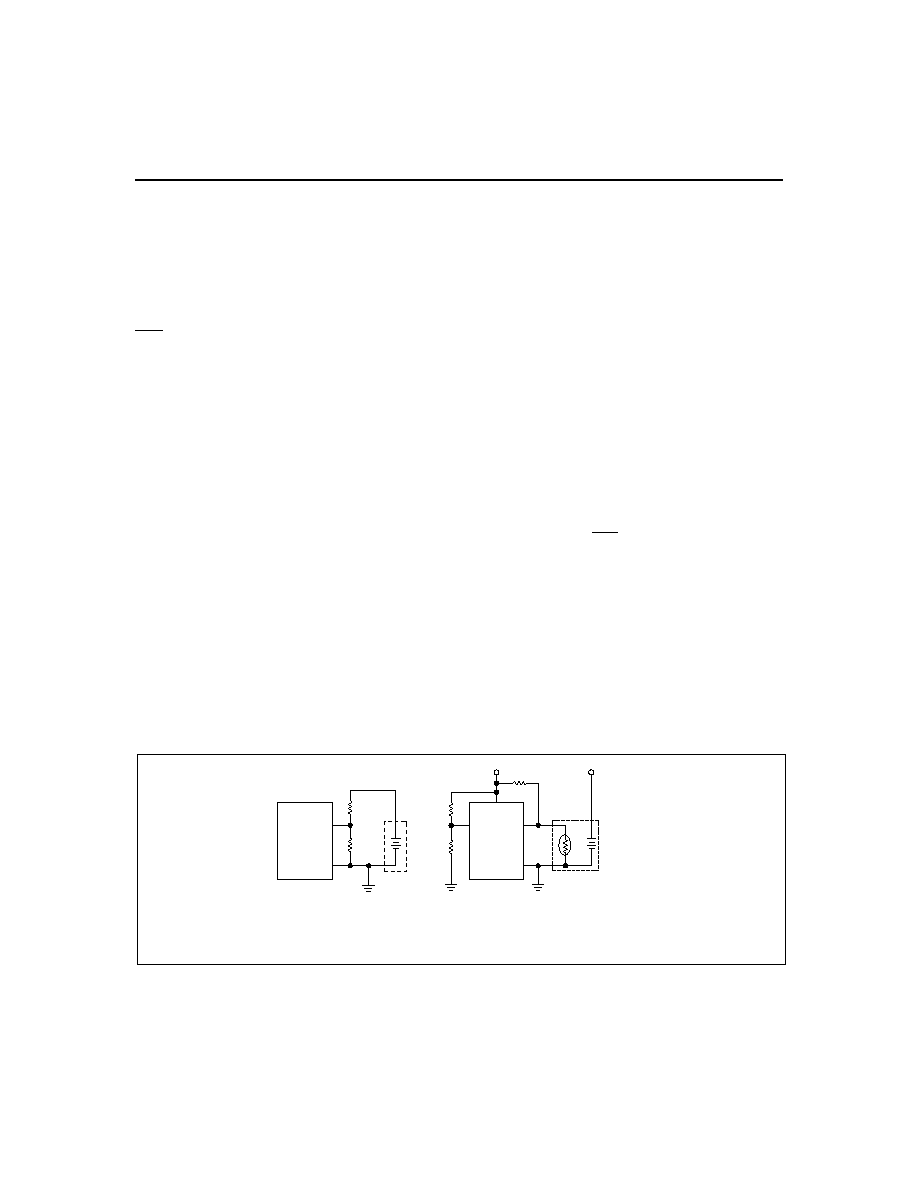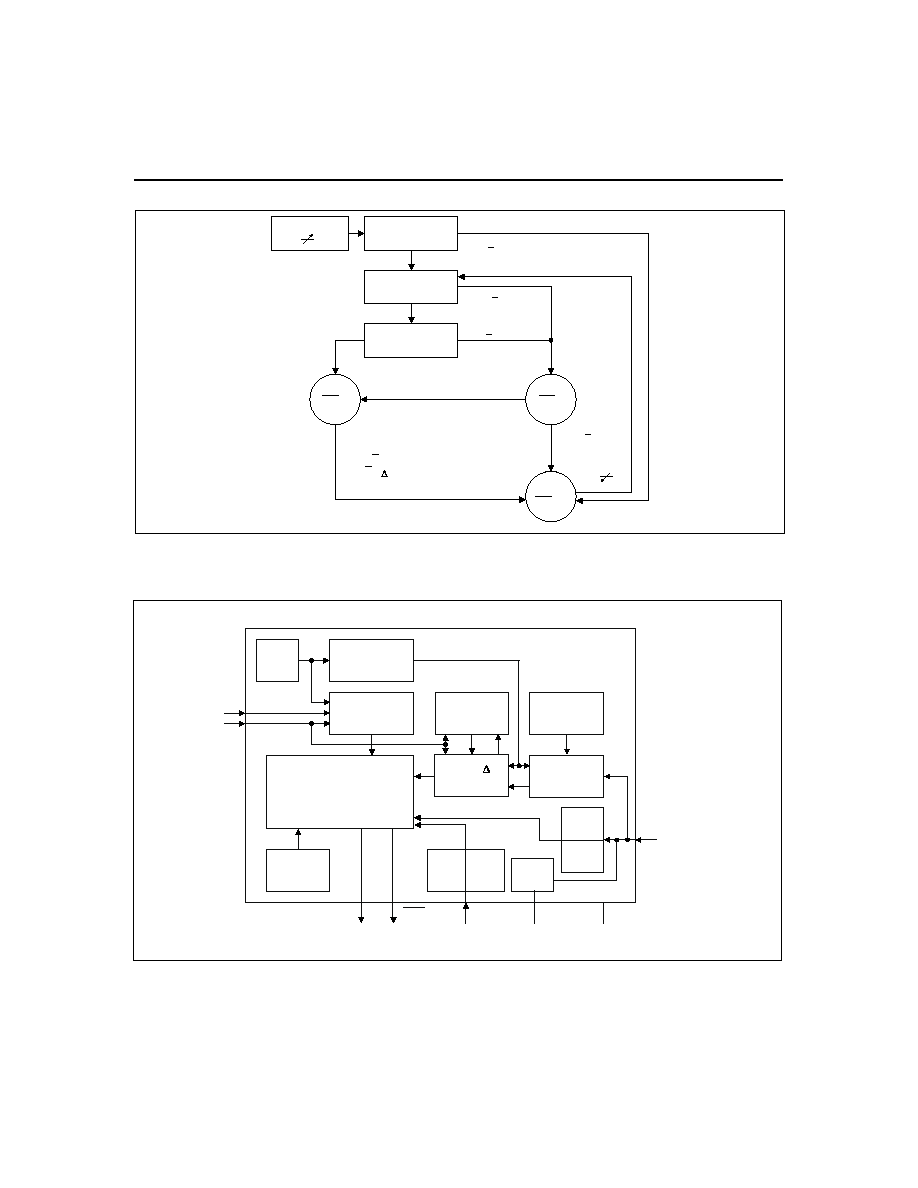 | –≠–ª–µ–∫—Ç—Ä–æ–Ω–Ω—ã–π –∫–æ–º–ø–æ–Ω–µ–Ω—Ç: BQ2002C | –°–∫–∞—á–∞—Ç—å:  PDF PDF  ZIP ZIP |

1
Features
Fast charge of nickel cadmium
or nickel-metal hydride batter-
ies
Direct LED output displays
charge status
Fast-charge termination by -
V,
maximum voltage, maximum
temperature, and maximum
time
Internal band-gap voltage ref-
erence
Selectable pulse-trickle charge
rates
Low-power mode
8-pin 300-mil DIP or 150-mil
SOIC
General Description
The bq2002C Fast-Charge IC is a low-
cost CMOS battery-charge controller
providing reliable charge termination
for both NiCd and NiMH battery appli-
cations.
Controlling a current-limited
or constant-current supply allows the
bq2002C to be the basis for a cost-
effective stand-alone or system-inte-
grated charger.
The bq2002C inte-
grates fast charge with pulsed-trickle
control in a single IC for charging one
or more NiCd or NiMH battery cells.
Fast charge is initiated on application
of the charging supply or battery
replacement. For safety, fast charge is
inhibited if the battery temperature
and voltage are outside configured
limits.
Fast charge is terminated by any of
the following:
n
Peak voltage detection (PVD)
n
Negative delta voltage (-
V)
n
Maximum voltage
n
Maximum temperature
n
Maximum time
After fast charge, the bq2002C pulse-
trickles the battery per the pre-
configured limits. Fast charge may be
inhibited using the INH pin.
The
bq2002C may also be placed in low-
standby-power mode to reduce
system power consumption.
NiCd/NiMH Fast-Charge Management IC
bq2002C
TM
Timer mode select input
LED
Charging status output
BAT
Battery voltage input
V
SS
System ground
1
PN-200201.eps
8-Pin DIP or
Narrow SOIC
2
3
4
8
7
6
5
TM
LED
BAT
VSS
CC
INH
VCC
TS
TS
Temperature sense input
V
CC
Supply voltage input
INH
Charge inhibit input
CC
Charge control output
Pin Connections
Pin Names
9/97 B

Pin Descriptions
TM
Timer mode input
A three-level input that controls the settings
for the fast charge safety timer, voltage ter-
mination mode, pulse-trickle, and voltage
hold-off time.
LED
Charging output status
Open-drain output that indicates the charging
status.
BAT
Battery input voltage
The battery voltage sense input. The input to
this pin is created by a high-impedance re-
sistor divider network connected between
the positive and negative terminals of the
battery.
V
SS
System ground
TS
Temperature sense input
Input for an external battery temperature
monitoring thermistor.
V
CC
Supply voltage input
5.0V
±
20% power input.
INH
Charge inhibit input
When high, INH suspends the fast charge in
progress.
When returned low, the IC re-
sumes operation at the point where initially
suspended.
CC
Charge control output
An open-drain output used to control the
charging current to the battery. CC switch-
ing to high impedance (Z) enables charging
current to flow, and low to inhibit charging
current. CC is modulated to provide pulse
trickle.
Functional Description
Figure 2 shows a state diagram and Figure 3 shows a
block diagram of the bq2002C.
Battery Voltage and Temperature
Measurements
Battery voltage and temperature are monitored for
maximum allowable values. The voltage presented on
the battery sense input, BAT, should represent a
single-cell potential for the battery under charge.
A
resistor-divider ratio of
RB1
RB2
= N - 1
is recommended to maintain the battery voltage within
the valid range, where N is the number of cells, RB1 is
the resistor connected to the positive battery terminal,
and RB2 is the resistor connected to the negative
battery terminal. See Figure 1.
Note: This resistor-divider network input impedance to
end-to-end should be at least 200k
and less than 1 M
.
A ground-referenced negative temperature coefficient
thermistor placed near the battery may be used as a low-
cost temperature-to-voltage transducer. The temperature
sense voltage input at TS is developed using a resistor-
thermistor network between V
CC
and V
SS
. See Figure 1.
2
bq2002C
Fg2002/C.eps
bq2002C
BAT
VSS
N
T
C
bq2002C
VCC
VCC
PACK +
TS
VSS
BAT pin connection
Thermistor connection
TM
NTC = negative temperature coefficient thermistor.
RT
R3
R4
RB1
RB2
Mid-level
setting for TM
Figure 1. Voltage and Temperature Monitoring and TM Pin Configuration

3
bq2002C
Chip on
VCC 4.0V
Battery Voltage
too High?
Battery
Temperature?
Charge
Pending
Fast
LED =
Low
SD2002C.eps
Battery Voltage
too Low?
VBAT < 2V
VTS < VCC/2
VTS > VCC/2
VBAT > 0.84V and
VBAT < 2V and
VTS > VCC/2
VBAT < 0.84V
0.84V < VBAT
VBAT
>
2V
Trickle
LED =
Flash
Trickle
LED = Z
VBAT > 2V or
VTS < VCC/2 or
PVD or - V or
Maximum Time Out
VBAT > 2V
VBAT 2V
Figure 2. State Diagram
OSC
TM
CC
LED
VCC
VSS
BAT
INH
Clock
Phase
Generator
Timing
Control
Sample
History
A to D
Converter
MCV
Check
Power
Down
TS
Bd2002CEG.eps
Voltage
Reference
Power-On
Reset
TCO
Check
HTF
Check
LBAT
Check
Charge-Control
State Machine
PVD, - V
ALU
Figure 3. Block Diagram

Starting A Charge Cycle
Either of two events starts a charge cycle (see Figure 4):
1. Application of power to V
CC
or
2. Voltage at the BAT pin falling through the maximum
cell voltage V
MCV
where
V
MCV
= 2V
±
5%.
If the battery is within the configured temperature and
voltage limits, the IC begins fast charge.
The valid
battery voltage range is V
LBAT
< V
BAT
< V
MCV,
where
V
LBAT
= 0.175
V
CC
±
20%
The valid temperature range is V
TS
> V
HTF
where
V
HTF
= 0.6
V
CC
±
5%.
If V
BAT
V
LBAT
or V
TS
V
HTF
, the IC enters the charge-
pending state.
In this state pulse trickle charge is
applied to the battery and the LED flashes until the
voltage and temperature come into the allowed fast
charge range or V
BAT
rises above V
MCV
. Anytime V
BAT
V
MCV
, the IC enters the Charge Complete/Battery
Absent state. In this state the LED is off and trickle
charge is applied to the battery until the next new
charge cycle begins.
Fast charge continues until termination by one or more of
the five possible termination conditions:
n
Peak voltage detection (PVD)
n
Negative delta voltage (-
V)
n
Maximum voltage
n
Maximum temperature
n
Maximum time
4
Corresponding
Fast-Charge
Rate
TM
Termination
Typical
Fast-
Charge
Time Limits
(minutes)
Typical PVD
and -
V
Hold-Off
Time (seconds)
Pulse-
Trickle
Rate
Pulse-
Trickle
Pulse Width
(ms)
Maximum
Synchronized
Sampling
Period
(seconds)
C/2
Mid
PVD
160
300
C/32
73
18.7
1C
Low
PVD
80
150
C/32
37
18.7
2C
High
-
V
40
75
C/32
18
9.4
Notes:
Typical conditions = 25∞C, V
CC
= 5.0V
Mid = 0.5 * V
CC
±0.5V
Tolerance on all timing is ±12%.
Table 1. Fast-Charge Safety Time/Hold-Off Table
bq2002C
TD2002C1.eps
Fast Charging
VCC = 0
Fast Charging
CC Output
LED
Charge initiated by application of power
Charge initiated by battery replacement
Pulse-Trickle
See
Table 1
1s
Figure 4. Charge Cycle Phases

PVD and -
V Termination
There are two modes for voltage termination, depend-
ing on the state of TM. For -
V (TM = high), if V
BAT
is
lower than any previously measured value by 12mV
±
3mV, fast charge is terminated. For PVD (TM = low or
mid), a decrease of 2.5mV
±
2.5mV terminates fast
charge. The PVD and -
V tests are valid in the range
1V < V
BAT
< 2V.
Synchronized Voltage Sampling
Voltage sampling at the BAT pin for PVD and -
V termi-
nation may be synchronized to an external stimulus
using the INH input.
Low-high-low input pulses
between 100ns and 3.5ms in width must be applied at
the INH pin with a frequency greater than the "maxi-
mum synchronized sampling period" set by the state of
the TM pin as shown in Table 1. Voltage is sampled on
the falling edge of such pulses.
If the time between
pulses is greater than the synchronizing period, voltage
sampling "free-runs" at once every 17 seconds. A sample
is taken by averaging together voltage measurements
taken 57
µ
s apart. The IC takes 32 measurements in
PVD mode and 16 measurements in -
V mode.
The
resulting sample periods (9.17 and 18.18ms, respec-
tively) filter out harmonics centered around 55 and
109Hz. This technique minimizes the effect of any AC
line ripple that may feed through the power supply from
either 50 or 60Hz AC sources. If the INH input remains
high for more than 12ms, the voltage sample history
kept by the IC and used for PVD and -
V termination
decisions is erased and a new history is started. Such a
reset is required when transitioning from free-running
to synchronized voltage sampling. The response of the
IC to pulses less than 100ns in width or between 3.5ms
and 12ms is indeterminate. The tolerance on all timing
is
±
12%.
Voltage Termination Hold-off
A hold-off period occurs at the start of fast charging.
During the hold-off time, the PVD and -
V terminations
are disabled. This avoids premature termination on the
voltage spikes sometimes produced by older batteries
when fast-charge current is first applied.
Maximum
voltage and temperature terminations are not affected
by the hold-off period.
Maximum Voltage, Temperature, and Time
Any time the voltage on the BAT pin exceeds the maxi-
mum cell voltage, V
MCV
, fast charge is terminated.
Maximum temperature termination occurs anytime the
voltage on the TS pin falls below the temperature cut-off
threshold V
TCO,
where
V
TCO
= 0.5
V
CC
±
5%.
Maximum charge time is configured using the TM pin.
Time settings are available for corresponding charge
rates of C/2, 1C, and 2C. Maximum time-out termina-
tion is enforced on the fast-charge phase, then reset, and
enforced again on the top-off phase, if selected. There is
no time limit on the trickle-charge phase.
Pulse-Trickle Charge
Pulse-trickle is used to compensate for self-discharge
while the battery is idle in the charger. The battery is
pulse-trickle charged by driving the CC pin active once
per second for the period specified in Table 1.
This
results in a trickle rate of C/32.
TM Pin
The TM pin is a three-level pin used to select the
charge timer, top-off, voltage termination mode, trickle
rate, and voltage hold-off period options.
Table 1
describes the states selected by the TM pin.
The
mid-level selection input is developed by a resistor
divider between V
CC
and ground that fixes the volt-
age on TM at V
CC
/2
±
0.5V. See Figure 4.
Charge Status Indication
A fast charge in progress is uniquely indicated when the
LED pin goes low. In the charge pending state, the LED
pin is driven low for 500ms, then to high-Z for 500ms.
The LED pin is driven to the high-Z state for all other
conditions. Figure 2 outlines the state of the LED pin
during charge.
Charge Inhibit
Fast charge and top-off may be inhibited by using the
INH pin. When high, INH suspends all fast charge and
top-off activity and the internal charge timer.
INH
freezes the current state of LED until inhibit is
removed. Temperature monitoring is not affected by the
INH pin. During charge inhibit, the bq2002C continues
to pulse-trickle charge the battery per the TM selection.
When INH returns low, charge control and the charge
timer resume from the point where INH became active.
Low-Power Mode
The IC enters a low-power state when V
BAT
is driven
above the power-down threshold (V
PD
) where
V
PD
= V
CC
- (1V
±
0.5V)
Both the CC pin and the LED pin are driven to the
high-Z state. The operating current is reduced to less
than 1
µ
A in this mode. When V
BAT
returns to a value
below V
PD
, the IC pulse-trickle charges until the next
new charge cycle begins.
5
bq2002C




